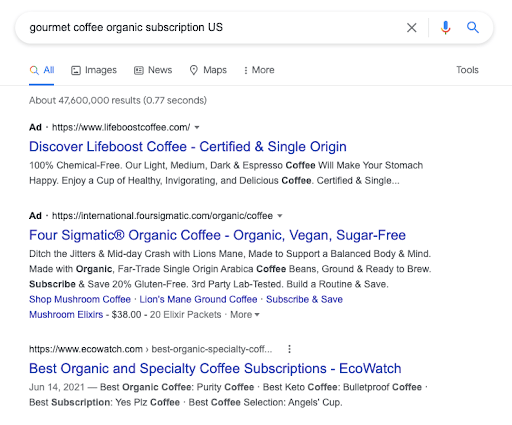Knowing your own products like the back of your hand is essential for getting your e-commerce store going. But stacking your offering up against the competition is what will keep it growing!
This is where competitor analysis comes in. It’s a handy competitive research tool that can help you effectively carve out an ever larger share of your market.
Competitor analysis can benefit you in multiple situations:
- Maybe you’re launching a new product and need to know how to present it,
- Maybe your brand is feeling stale and you need ideas (a great way to re-engage existing customers),
- Maybe you noticed your sales growth slowing, or even stopping completely,
- Or maybe you simply have some downtime in your marketing schedule and want to sharpen up your message and ads in relation to your competitors.
Whatever stage your business is at, analysing your competitors can help you find new opportunities and keep on top of industry trends.
Evaluating your competition might seem like a daunting task, but we’ve prepared a detailed guide to all things competitor analysis.
In this blog, you’ll find:
- A definition of what competitor analysis is;
- A breakdown of its main benefits;
- A step-by-step guide to conducting a competitor analysis yourself;
- A free competitive analysis template you can use for your e-commerce store;
- And some tips and tricks for getting your competitor analysis right.
Ready to beat the competition? Then read on!

What is a competitive analysis?
A competitive analysis - also known as a competitor analysis - is a process of evaluating what your current and potential competitors are up to. It involves looking at what the businesses you compete with are doing, and, more importantly, deciding on what you can do in response.
Competitor analysis is about understanding your competition by evaluating:
- their products,
- their marketing and sales strategies,
- their customers and audience,
- and their strengths and weaknesses.
So it’s less about just comparing prices and more about understanding the businesses operating in your niche, and what advantages you might have over them.
Analysing competitors is a crucial step in your business planning process. Ultimately, you’re going head-to-head with your competition to win the loyalty of the exact same customer base. Competitor analysis is a tool that reveals critical insights that can help you come out on top in this race.
What are the benefits of doing a competitive analysis?
The biggest benefit is that you will understand how to turbo-charge your business’ growth. That’s because you will know how to compete in the market. A clear competitive analysis will make any business decision you take more informed and more likely to succeed.
Here’s a breakdown of some of the main benefits of doing a competitive analysis:
Finding a competitive edge
While market research helps you find customers for your business, competitor analysis helps you make your business unique. A customer’s first question will be: Why do I need this product? But their second will be: Why do I need your version of this product? Focusing attention on your current and potential competition will help zero-in on specific product features, pricing strategies, and marketing approaches that can distinguish your brand from its competitors and persuade customers to pick you.
Learning from others
Competitive analysis helps you understand the businesses competing for your potential customers. This is key to figuring out where you can improve. By analysing your competitors, you can not only learn their best practices, but also avoid some of the mistakes that they’ve made.
Managing threats and reducing risk for your business
Even if your sales are rocketing right now, how can you be sure that this will continue? Understanding your competitive landscape well makes you better prepared to face any unpleasant surprises. Competitor analysis allows you to identify your competitive vulnerabilities and keep an eye on potential threats. Scoping out where customers may go if they don’t choose you is a good way of making sure it doesn’t happen.
Capitalizing on opportunities
Is there a product or niche that is on fire right now, and could propel your store from five figure earnings to six figure? Well, there might be, but without competitive analysis there’s a good chance you’ll miss it. Competitive analysis makes it easier to spot gaps in the market and jump on these opportunities while they’re still hot.
Planning ahead
Many businesses find themselves wrong-footed, not because they did something wrong, but because they failed to anticipate changes in the market. A competitor analysis will help you identify the strategies your competition uses to provide value to your target buyers. By looking at these strategies, you can better recognise how you can enhance your own long-term business strategy, or find alternative strategies to attract additional customers. Just imagine you’re selling DVDs online right before Netflix launched its streaming service! If you’re analysing the competition, you’d understand that your business needs to change (maybe a pivot to movie merchandise instead).
The more you can understand the businesses that directly and indirectly compete with you, the better you’re equipped for success. In essence, competitor analysis is a way to ensure you are one step ahead of your competition.
So, with no further ado, let’s see how it’s done.
A step by step guide to conducting a competitor analysis
It’s easy to burn hours of time on competitor analysis. To save you some time, we have set out a structured step-by-step guide that should help keep you focused on what to look for and where.
Let’s get into the how-to’s of a competitive analysis in 6 easy steps:
Step 1: Create a spreadsheet for collecting the data
The first step is the least interesting, but it’s important. You’ll need to be ultra organized when conducting your analysis, so get a spreadsheet set up. Make sure everyone working on the analysis can access it.
And in terms of the content of the spreadsheet, we’ll leave that for later in this blog, when we present your very own template for conducting a competitive analysis.
Step 2: Identify your competitors
It’s time to find the competition. Of course, good ol’ Google will be a valuable tool here. But one important point to remember is that you should always add modifiers to your search terms. These are additional words or phrases that will dramatically narrow down the number of results for a search, and help you find your direct competitors more easily.
For example, imagine you’re a US-based e-commerce business that sells monthly subscriptions of organic gourmet coffee. If you simply search for “Gourmet Coffee”, you return over 375 million results. And the first is a blog about coffee, not a competitor.
Now add the modifiers “Monthly subscription” + “US” + “organic” and you get an 87.5% reduction in search results. Plus, all the results are for e-commerce coffee stores. Bingo!

Once you have tried the most obvious modifiers, make some variations like “best”, “cheapest”, and “fastest delivery”. And don’t forget Google tries to work out the intention of a search too (eg. whether you’re trying to buy something, research something, compare something etc.) So adding “buy” or “for sale” into your search enquiry might also help with honing in on your competitors.
Step 3 - Define your competitors by type
Once you have a list of competitors, it’s time to organise them a bit. The key categorization is to divide them into direct competitors and indirect competitors.
Direct competitors
These are e-commerce stores that are offering the same products (or very similar) to the same audience (or very similar) as you are. So, to go back to our coffee subscription example, any other e-commerce stores selling coffee as a subscription to customers in the same region and demographic would be a direct competitor.
Indirect competitors
These are e-commerce stores that are selling a similar product to you, but with some crucial differences. For example, you might be at opposite ends in terms of pricing (luxury vs low end). For our subscription gourmet coffee store, indirect competitors would either be those selling cheap, lower quality coffee, or those not selling as a subscription. You could even consider competitors selling a different product that solves a similar problem. For example, if you’re selling vitamin supplements, you may consider standard pharmaceuticals to be your competitors.
A different approach for different competitor types
It’s important to be careful when categorising your competitors into direct or indirect, because the way you respond to these types of competitors will differ.
In the case of direct competitors, you might need to change specific parts of your product or service in response to what you discover about your competitors. Furthermore, when you’re targeting the same audience you’ll need to focus on specific benefits (like free shipping) that you can offer over your direct competitors.
But with indirect competitors, you might think more about persuasion. How can I get a customer who buys low-end coffee interested in trying gourmet coffee instead? So you’re going to focus less on the specifics, and more on the general benefit you have to offer.
Step 4 - Analyse each competitor’s value proposition and positioning
Now things are starting to sound a bit “advertising agency.” But don’t worry, fancy terms like “value proposition” and “positioning” describe really simple ideas. Here’s what they mean:
- Value proposition - a summary of the main reasons to choose a product or brand.
- Positioning - where a brand fits within the overall market.
Analysing these elements are important, because they give you a lot of information about the company’s product, service, and audience. And this gives you an opportunity to stand out.
For example, take a look at this value proposition from Apple: Looks brand new. Feels like home.
Apple is emphasising an important feature to their customers - the fact that its new iPhone looks modern, but will feel familiar for Apple users.
Understanding this gives you important information about who Apple is targeting - existing Apple users looking for an iPhone upgrade. So, if you’re Samsung you can come up with a distinctive and different message. Something like this:

By creating a different value proposition - one focused on discovery - you stand out and offer something different. If you’re thinking about your own value proposition and how to make it stand out, check out this list of 9 great value proposition examples to get you inspired.
How to find your competitor’s value proposition and market positioning
While companies communicate a lot about their value proposition and market positioning, it can sometimes take a little bit of digging to find it. Here are some tips you can follow to make the process easier.
Go to the about us section of your competitor’s website then:
- Note what they say their mission is. For example, if they say their mission is to “Make gourmet accessible to more people”, this probably means they’re cheap and are targeting the low end of the market. If they say they want to “Provide lovers of coffee with unique tasting opportunities,” this means they’re highly personalised (and therefore probably expensive).
- See if your competitor compares itself directly to other products on the market. For example, Four Sigmatic spell out on their website exactly where they see themselves in the health food market.
You should also take a look at their social media activity. This can give you a good snapshot of their size and activity, and help you identify their target audience too.
Step 5 - Compile this data in one place
Add all the data you’ve gathered into your spreadsheet. You could create a scoring system to make it easier to analyse and help you pick out key trends.
Step 6 - Find your competitive advantage
Here comes the toughest part. But this is the whole point of the exercise - to find a way to present yourself that will give you an advantage over your competitors.
Start with your direct competitors. Look through your data to see if there are any gaps in the market positions. Are there loads of competitors in the low-end side of your market, but very few in the luxury segment. Or perhaps everyone is focusing on free shipping, but very little is mentioned about flexible returns policies.
Once you have looked through each competitor, you’ll need to turn the attention onto your e-commerce store. Ask yourself:
- What are our biggest strengths as a team?
- What do we do badly or find challenging?
- What do we enjoy and value most?
For example, let’s say you realise that you are highly creative but not so great at organisation. Then it would make sense for you to focus on building a brand people love by being active on social media, rather than thinking about logistics-intensive benefits like flexible returns.
Combine the two (your analysis of your direct competitors and your reflection on yourself) to find the perfect competitive advantage for you.
For example, take a look at this brilliant ad by Atoms shoes.
Here is a brand that knows exactly what its competitive advantage is:
creating comfortable, long-lasting shoes made from high quality materials.
They even spell out exactly what they’re not.
This level of clarity is what you’re aiming for with your competitive analysis.
Finally, once you have identified your competitive advantage, take a look at your secondary competitors. You might spot gaps in the market, or think of ways to convince some of their audience to try your product.
A competitive analysis template
You’ve got a clear idea of the steps you’ll need to follow for your competitive analysis. Now, as promised, here’s a handy template you can use. It’s designed for general use for e-commerce stores, but of course you can adapt or tailor to your specific niche.
We’ve filled in the answers for our fictional gourmet coffee store to give you an idea of how to answer each section.
| Competitor 1 | Competitor 2 | Competitor 3 | |
|---|---|---|---|
| Company name | New Cup Coffee | Coffee Direct | Rare beans |
| Target audience | Men and women aged 30 - 55 | Men and women aged 20 - 30 | Men and women aged 30 - 55 |
| Value proposition | Experts recommend new coffees each month | Next day delivery of all weekday orders | Sourced from unusual / rare locations |
| Market position | Mid-level qualityLow-level personalisation | Low-level qualityHigh-level personalisation | High-level qualityMid-level personalisation |
| Competitive advantages | Great for beginners who want to explore + large social following | Fastest delivery + lower prices | Appeals to niche coffee enthusiasts + luxury market |
| Marketing content | Video tutorials on Youtube / social media ads | Good ranking on Amazon, social media ads | Newsletter, SEO oriented blog |
| Price range | From $22.50 monthly subscription | From $15 monthly subscription | From $30 monthly subscription |
Tips and tricks for successful competitor analysis
OK, just time for 5 handy tips to you should follow when you’re carrying out your competitor analysis.
- Analyse web traffic and organic performance: If organic traffic is a key component of your marketing strategy, look for organic competitors by seeing whose content performs well for specific search queries. You’ll need to look at the content they create and see how you can offer more value. You can also use tools like ahrefs or semrush to get more granular. Useful metrics to look for are number of referring domains and volume of organic search traffic.
- Check out the ads your competitors are running: If you rely mainly on ads for your marketing, look at your competitors ads to see how they engage their audience and sell their product. Here’s a step by step guide on how to find your competitor’s ads.
- Know when enough is enough: Although it’s always sensible to do competitor analysis, avoid obsessively researching every possible competitor. It’s easy to take research to the point where you get stuck in ‘analysis paralysis’ and never get round to actually taking action so your business grows. You could try limiting competition analysis to once every 3 or 6 months, and be tight on how long you give yourself for the process.
- Take everything you see from your competitors with a pinch of salt: Don’t assume that everything a competitor does actually works well. When looking at a competitor’s glossy website, it’s easy to think everything is perfect. But few businesses get everything 100% right for their customers. And many businesses do things that aren’t always ideal or profitable, but due to other pressures they never get round to changing. Even if it is right for them, it might not be right for you.
- Repeat, repeat, repeat at regular intervals: Competitive analysis isn’t a one-and-done exercise. While the frequency of analysis can differ depending on the industry, we recommend conducting a competitor analysis anytime from once a quarter to once a year. This gives you time to react to your discoveries and benchmark your progress.
Competitive analysis - the takeaways and FAQs
Competitive analysis is an important tool in maintaining your store’s continuous growth. By keeping tabs on what the other e-commerce stores in your niche are doing, you can:
- Constantly improve and clarify your value proposition so you really stand out in the market,
- Identify opportunities in the market that can bring in big bucks,
- Manage potential risks in the future so that your business is secure for the long term.
And to carry out a successful competitive analysis, just adapt the competitor analysis example template in this article to fit your specific area of business. Then follow these 6 steps:
- Create a competitive analysis spreadsheet based on the template in this article,
- Identify your competitors (don’t forget to use a range of modifiers when you’re searching for them on Google)
- Define your competitors by type (separate them into direct and indirect competitors)
- Analyse your competitors’ value propositions and market positioning (for analysing your competitors’ social media activity, take a look at this guide to spying on your competitors’ ads in Instagram and Facebook.)
- Compile all your data in your competitive analysis spreadsheet
- Find your competitive advantage (after all, this is the main benefit of conducting a competitive analysis).
So, you’ve got the competitive analysis template. And you’ve got the steps for completing your competitive analysis. Now all you need is schedule some time to put this strategy into action (we recommend once every 3-6 months, and annually at the very least). Then get ready to propel your business’ growth and secure its long-term future.
FAQ
What is competitive analysis?
A competitive analysis - also known as a competitor analysis - is like an audit. You gather information on who your competitors are and what they’re doing. This usually includes looking at their products, their marketing and sales strategies, their customers and audience, and the strengths and weaknesses of their business.
How does it work?
There are 6 keys steps to follow when conducting your competitive analysis: create a spreadsheet (based on the template in this article), identify your competitors, categorise them into direct and indirect competitors, analyse them, compile your data, and then identify your competitive advantage.
Why is it worth doing?
There are 3 main reasons to conduct a competitive analysis. The first, and most important, is to identify your own competitive advantages. See what you can offer that your competitors can’t and use this to attract new customers. Secondly, a competitive analysis will help you identify new opportunities and gaps in the market. Thirdly, it will enable you to secure your business’ future by being ready for changes and shifts in the market.




